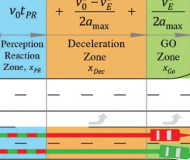3/3/2020
Engineering Board Issues Guidelines For Longer Yellow TimesITE publishes new guidelines establishing longer yellow light duration for left turns.

The organization that led the charge for lowering yellow times around the nation decades ago conceded Monday that it may have gone too far. The Institute of Traffic Engineers (ITE) released formal guidelines lengthening the yellow warning times for left-turn lanes at intersections to as long as seven full seconds.
"ITE has concluded a years-long effort to issue guidance on yellow change and red clearance intervals for signalized intersections," ITE senior director Doug Noble wrote in the organization's March journal. "This report is not intended to cover specific enforcement actions to address red light running, but does acknowledge that the range of values for variables used in calculating change intervals and the range of driver behavior they represent makes zero tolerance enforcement inappropriate."
A motorist approaching an intersection that is about to display a red light needs enough warning from the yellow light to either come to a safe stop, or to proceed safely through the intersection. Yellows that are overly short can create what is called a 'dilemma zone' in which there is not enough time to stop safely, and there is no way to get through the intersection without running the red light.
The new ITE guidelines are based on an "extended" equation that for the first time takes into account the extra time needed when turning. The change was spurred by the research of Oregon engineer Mats Jarlstrom, Safer Streets LA executive director Jay Beeber, North Carolina professional engineer Brian Ceccarelli, and the National Motorists Association's professional engineer Joe Bahen. In addition to making their point mathematically, the group set up a real-life demonstration that proved the previous ITE recommendation tended to create dilemma zones for drivers making turns. ITE acknowledged that more change might be needed, if justified by the facts.
"It is widely thought that longer change intervals can lead to unsafe behavior once drivers are aware of and familiar with them," ITE chief technical officer Jeffrey A. Lindley wrote. "However, this understanding is very anecdotal in nature and available literature is not definitive on this issue. Continued research in this area would be improve the body of knowledge."
Many jurisdictions, such as New York, combine the use of the bare minimum legal yellow time of 3.0 seconds with zero tolerance red light camera enforcement. The automated machines in Manhattan mail out tickets for alleged violations as little as 0.1 seconds after the light turns red. A study by the Texas Transportation Institute concluded that overly short yellow times created red light running violations because the majority of straight-through red light violations happen when a driver misjudges the end of the yellow light by less than 0.25 seconds (view chart). The TTI study also confirmed that accidents went down when yellow times were raised (view report).
The new ITE guideline is only a recommendation, but it carries the force of law at photo enforced locations in states like Virginia that have adopted the ITE methodology by statute. The new document represents the first formal revision to the signal timing practice since 2001. A congressional report (view document) issued that year accused ITE of changing its practices over time in a way that reduced yellow times as a way of accommodating the use of red light cameras. As ITE's own 1994 task force put it, "enforcement can be used instead" of longer yellow time to control red light running at intersections.
"ITE believes that the extended kinematic equation has a sound theoretical basis for use in calculating change and clearance intervals for through and left turn movements (in fact, for through movements, the extended kinematic equation reduces to the more familiar traditional kinematic equation)," ITE explained. "We believe its use will result in slightly longer but more appropriate change intervals for left turning movements, which should enhance safety."


